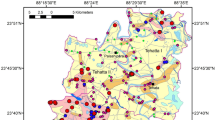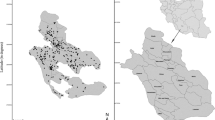Abstract
Geological and hydrogeological processes are complex and in the many measurements, this complexity with nonuniform distribution becomes more visible. Usually, temporal and spatial measurements of physical or chemical processes cannot detect the main dominated processes. The data reduction of multivariate analysis, try’s to classify, interpretation and detecting the main govern processes, which in this present study were used to determining the origin of hydrochemical anomalies. To assess the major and minor elements of Miandoab plain, 54 groundwater samples were collected. In addition, 36 groundwater samples were collected and analyzed for assessing the trace elements in the study area. Factor analysis, Pearson correlation, and Hierarchical clustering methods were used to analyzing the hydrochemical results. According to the results of the Multivariate statistical methods and due to the high correlation of arsenic with iron and silica, the origin of arsenic is attributed to the dissolution of rocks and sediments in the region. The presence of Sahand volcanic mountains in the area and the spread of igneous rocks are contributing to the arsenic anomaly in the area. Based on the cluster analysis, samples S3, S4, S5, S14, and S18, which have a more anomaly of trace element, were placed in one subcluster and indicate the geogenic origin of As, Fe, and SiO2. Also, samples S7 and S20 with more anomaly of arsenic can represent the anthropogenic origin of arsenic. The use of herbicides and pesticides in the study area has been identified as a major cause for anomalous concentrations of arsenic in these samples.












Similar content being viewed by others
References
Ahmad A, Bhattacharya P (2019) Environmental arsenic in a changing world. Groundw Sustain Dev 8:169–171. https://doi.org/10.1016/j.gsd.2018.11.001
Alvarez-Ayuso E, Querol X, Ballesteros JC, Giménez A (2008) Risk minimization of FGD gypsum leachates by incorporation of aluminum sulphate. Sci Total Environ 406:69–75. https://doi.org/10.1016/j.scitotenv.2008.08.010
Babel S, Opiso E (2007) Removal of Cr from synthetic wastewater by sorption into volcanic ash soil. Int J Environ Sci 4(1):99–108
Barzegar R, Asghari Moghaddam A, Kazemian N (2015) Assessment of heavy metals concentrations with emphasis on arsenic in the Tabriz plain aquifers, Iran. J Environ Earth Sci 74(1):297–313
Bhowmick S, Pramanik S, Singh P, Mondal P, Chatterjee D, Nriagu J (2018) Arsenic in groundwater of West Bengal, India: a review of human health risks and assessment of possible intervention options. Sci J Total Environ 612:148–169
Bu H, Tanm X, Li S, Zhang Q (2010) Water quality assessment of the **shui River (China) using multivariate statistical techniques. J Environ Earth Sci 60:1631–1639
Davis A, Kempton J, Nicholson A (1994) Groundwater transport of arsenic and chromium at a historical tannery. J Appl Geochem 9:569–582
Devi Oinam J, Ramanathan A, Singh G (2012) Geochemical and statistical evaluation of groundwater in Imphal and Thoubal district of Manipur, India. J Asian Earth Sci 48:136–149
Duruibe J, Ogwuegbu M, Egwurugwu J (2007) Heavy metal pollution and human bio toxic effects. Int J Phys Sci 2:112–118
Emberger L (1952) Sur le quotient pluviothermique, C.R. Sciences 234:2508–2511
Facchinelli A, Sacchi E, Mallen L (2001) Multivariate statistical and GIS-based approach to identify heavy metal sources in soils. J Environ Pollut 114:313–324
Farooq SH, Chandrasekharam D, Berner Z, Norra S, Stüben D (2010) Influence of traditional agricultural practices on mobilization of arsenic from sediments to groundwater in Bengal delta. J Water Res 44:5575–5578
Gurunadha Rao V, Dhar R, Subrahmanyam K (2001) Assessment of contaminant migration in groundwater from an industrial development area Medak district, Andhra Pradesh, India. Water Air Soil Pollut 128:369–389
Jain CK, Ali I (2000) Arsenic occurrence toxicity and speciation techniques. J Water Resour 34(17):4304–4312
Kribek B, Majer V, Veselovský F, Nyambe I (2010) Discrimination of lithogenic and anthropogenic sources of metals and sulphur in soils of the central-northern part of the Zambian Copperbelt Mining District: a topsoil vs subsurface soil concept. J Geochem Explor 104:69–86
Lone S, Jeelani G, Abhijit M, Poulomee C (2020) Geogenic groundwater arsenic in high altitude bedrock aquifers of upper Indus river basin (UIRB), Ladakh. J Appl Geochem 113:104497
Mosaferi M, Yunesian M, Mesdaghinia AR, Nadim A, Nasseri S, Mahvi AH (2003) Arsenic occurrence in drinking water of L.R. of Iran- the case of Kurdistan province, In: Fate of Arsenic in the environment, Proceedings of the BUET-UNU international symposium, 5–6 February, Dhaka, Bangladesh, Sciences. 6 (13): 2705–2714
Nadiri AA, Asghari Moghaddam A, Sadeghi F, Aghaee H (2012) Investigation of arsenic anomalies in water resources of Sahand Dam. J Environ Stud 38(3):61–74
Ng JC, Wang J, Shraim AA (2003) Global health problem caused by arsenic from natural sources. J Chemosphere 52(9):1353–1359
Norbakhsk R, Ansari F, Daneshmand Irani K (2008) Determination of nitrate pollution in both natural mineral waters and bottled/packaging waters in Iran. Res J Biol Sci 3:999–1003
Norouzi H, Moghaddam AA, Nadiri AA (2016a) Determining vulnerable areas of Malekan plain aquifer for nitrate, using random forest method. J Environ Stud 41(4):923–942
Norouzi H, Moghaddam AA, Nadiri AA (2016b) Investigation of Malikan plain groundwater’s pollution to arsenic. J Ecohydrol 5(3):739–751
Norouzi H, Nadiri AA, Moghaddam AA (2018) Identifying the susceptible area of Malikan plain aquifer to contamination using fuzzy methods. J Environ Stud 44(2):205–221
Rubio B, Nombela M, Vilas F (2000) Geochemistry of major and trace elements in sediments of the Ria de Vigo (NW Spain): an assessment of metal pollution. Mar Pollut Bull 40:968–980
Shahrabi M (1972) Description of geological map of Urmia. Geological Survey of Iran, p 81
Smedley P, Kinniburgh D (2002) A review of the source, behavior and distribution of arsenic in natural waters. J Appl Geochem 17(12):517–568
Tlili-Zrelli B, Azaza F, Gueddari M, Bouhlila R (2012) Geochemistry and quality assessment of groundwater using graphical and multivariate statistical methods. A case study: Grombalia phreatic aquifer (Northeastern Tunisia). Arab J Geosci 6:3545–3561
USEPA (2001) Risk assessment guidance for superfund, human health evaluation. Manual part A, Interim final, vol 1. EPA/540/1-89/002
WARWA (West Azerbaijan Regional Water Authority) (2002) Groundwater studies and determination of hydraulic characteristics of the miandoab plain aquifer, 117 p
WARWA (West Azerbaijan Regional Water Authority) (2018) Preparation of water balance and water cycle in the Malekan region, 56 p
World Health Organization (WHO) (2017) Guidelines for drinking-water quality: incorporating the first addendum, 4th edn. World Health Organization
Wu Z, Mengchang H, Chunye L (2011) Distribution and speciation of four heavy metals (Cd, Cr, Mn, and Ni) in the surficial sediments from estuary in Daliao river and Yingkou bay. J Environ Earth Sci 63:163–175
Zhang B, Song X, Zhang Y, Han D, Tang C, Yu Y, Ma Y (2012) Hydrochemical characteristics and water quality assessment of surface water and groundwater in Songnen plain, Northeast China. J Water Res 46:2737–2748
Funding
The authors have not disclosed any funding.
Author information
Authors and Affiliations
Corresponding author
Ethics declarations
Conflict of interest
The authors have not disclosed any competing interests.
Additional information
Publisher's Note
Springer Nature remains neutral with regard to jurisdictional claims in published maps and institutional affiliations.
Rights and permissions
About this article
Cite this article
Norouzi, H., Moghaddam, A.A. Determining the origin of arsenic anomalies in groundwater using multivariate statistical methods (case study: Miandoab plain aquifer, NW of Iran). Environ Earth Sci 81, 301 (2022). https://doi.org/10.1007/s12665-022-10385-x
Received:
Accepted:
Published:
DOI: https://doi.org/10.1007/s12665-022-10385-x




